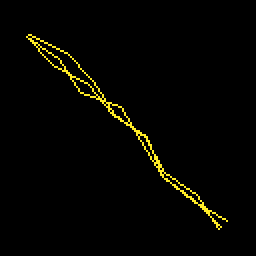There are several methods to creating a lightning bolt effect, such as using fractals or midpoint displacement. The method I’ll be using is dividing a line into segments, offseting each vertex, and drawing several of these segmented lines on top of one another.
First, since we’re using PICO-8, we’ll need some helper functions for getting the length of a line, slope of a line as a unit vector, and the unit normal of a line.
--Helper functions
function magnitude(x1,y1,x2,y2)
return sqrt((x2-x1)*(x2-x1)+(y2-y1)*(y2-y1))
end
function slope(x1,y1,x2,y2)
local l=magnitude(x1,y1,x2,y2)
local dx=(x2-x1)/l
local dy=(y2-y1)/l
return {dx,dy}
end
function normal(x1,y1,x2,y2)
local l=magnitude(x1,y1,x2,y2)
local dx=(x2-x1)/l
local dy=(y2-y1)/l
return {-dy,dx}
endNext, in a new tab, we’ll be making a Lightning object, which represents a line with two endpoints and evenly-spaced vertices in between. In the constructor, which I’m calling new(), we’ll add arguments for the two endpoints, the number of segments this object will have, and the color. Then we add a points array, which will hold the vertices of the line’s segments, and then generate these vertices by calculating the slope of the line, then breaking up the line into equal-length segments, and adding each vertex to the points array.
lightning={}
function lightning:new(x1,y1,x2,y2,n,c)
local o={}
setmetatable(o, self)
self.__index=self
o.x1=x1
o.x2=x2
o.y1=y1
o.y2=y2
o.color=c
o.points={}
--create the line segments
--make sure the minimum is 1
o.num_segments=flr(max(1,n))
local len=magnitude(x1,y1,x2,y2)/o.num_segments
local p1={x1,y1}
local p2={x2,y2}
add(o.points,p1)
local vec=slope(x1,y1,x2,y2)
for i=1,o.num_segments do
local p={p1[1],p1[2]}
p[1]+=i*len*vec[1]
p[2]+=i*len*vec[2]
add(o.points,p)
end
return o
endNow we’ll add a function to “generate” the lightning bolt, which really just means offsetting each vertex by adding the unit normal of the line to each one, scaled to a random amount. Note that each time this method is called, we also need to reset the positions of each vertex because otherwise, they’ll keep moving farther and farther away.
function lightning:generate()
local x1=self.x1
local y1=self.y1
local x2=self.x2
local y2=self.y2
local nor=normal(x1,y1,x2,y2)
local vec=slope(x1,y1,x2,y2)
local len=magnitude(x1,y1,x2,y2)/self.num_segments
for i=1,#self.points do
local p=self.points[i]
--First reset back to normal
p[1]=x1+(i-1)*len*vec[1]
p[2]=y1+(i-1)*len*vec[2]
--Then offset the point by adding the normal vector
local off=flr(rnd(12))-6
p[1]+=off*nor[1]
p[2]+=off*nor[2]
end
endThe offset applied to each vertex is hard-coded to be between -6 and 5, but you can change this to whatever you want, or even make it dynamic. Also note that each point, including the two endpoints, are offset. If you want an effect where the endpoints stay in place, you can change for i=1,#self.points do to for i=2,#self.points-1 do instead, which will ignore the first and last points.
Finally, we’ll add a draw() function to the Lightning object that will be called in the main _draw() function. In the draw function, we call PICO-8’s line() function by passing each pair of vertices in order.
function lightning:draw()
for i=1,#self.points-1 do
local p1=self.points[i]
local p2=self.points[i+1]
line(p1[1],p1[2],p2[1],p2[2],self.color)
end
endNow we can move on to the main loop. First we’ll create an array to hold Lightning objects, and in the _init() function we’ll create three Lightning objects and add them to this array.
lightning_bolt={}
function _init()
bolt=lightning:new(16,16,112,112,7,10)
bolt2=lightning:new(16,16,112,112,7,10)
bolt3=lightning:new(16,16,112,112,7,10)
add(lightning_bolt,bolt)
add(lightning_bolt,bolt2)
add(lightning_bolt,bolt3)
endNext, in the _draw() function, we loop through each Lightning object in the array and call their draw() function.
function _draw()
cls()
for v in all(lightning_bolt) do
v:draw()
end
endFinally, in the _update() function, for demonstration purposes, we’ll check if button 4 (Z/C/N) is being pressed, and if so, call generate() on all the Lightning objects in the array. That way, if you hold down the button, each lightning bolt will regenerate its vertices’ offsets, creating a lightning bolt effect.
function _update()
if btn(4) then
for v in all(lightning_bolt) do
v:generate()
end
end
endAfter implementing the above Lightning object, you can freely reuse it in any other projects too. You can add an update() function to it with custom behavior, or make generate() run constantly every set interval, or even manipulate the endpoints to make the lightning move around.

